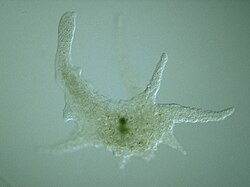Chaos (genus)
| Chaos | |
|---|---|
 |
|
| Chaos carolinensis | |
| Scientific classification | |
| Domain: | Eukarya |
| Phylum: | Amoebozoa |
| Class: | Tubulinea |
| Order: | Tubulinida |
| Family: | Amoebidae |
| Genus: |
Chaos Linnaeus, 1767 |
| Species | |
|
|
Chaos is a genus of amoebae, in the family Amoebidae. The largest and best known species, the so-called "giant amoeba" Chaos carolinense, can reach lengths of 5 mm, although most specimens fall between 1 and 3 mm.
Members of the genus closely resemble Amoeba and share the same general morphology, producing numerous cylindrical pseudopods, each of which is rounded at the tip. However, while Amoeba have a single nucleus, Chaos can have as many as a thousand. Because of this attribute, C. carolinensis was once placed in the genus Pelomyxa along with the other giant multinucleate amoeba, Pelomyxa palustris. Recently, molecular phylogenetic studies of this species have confirmed the view of some earlier researchers that it is more closely related to Amoeba than to Pelomyxa. The species is now placed in the independent genus Chaos, a sister group to Amoeba.
Chaos species are versatile heterotrophs, able to feed on bacteria, algae, other protists, and even small multicellular invertebrates. Like all Amoebozoa, they take in food by phagocytosis, encircling food particles with its pseudopodia, then enclosing them within a food ball, or vacuole, where they are broken down by enzymes. The cell does not have a mouth or cytostome, nor is there any fixed site on the cell membrane at which phagocytosis normally occurs.
The cell's membrane, or plasmalemma, is loose and extremely plastic, allowing the organism to change shape from one moment to the next. The cytoplasm within the membrane is conventionally described as having two parts: the internal fluid, or endoplasm, which contains loose granules and food vacuoles, as well as organelles such as nuclei and ; and a more viscous ectoplasm around the perimeter of the cell, which is relatively clear and contains no conspicuous granules. Like other lobose amoebae, Chaos move by extending pseudopodia. As a new pseudopod is extended, a variable zone of ectoplasm forms at the leading edge and a fountaining stream of endoplasm circulates within. The effort of describing these motions, and explaining how they result in the cell's forward movement, has generated a large body of scientific literature.
...
Wikipedia
